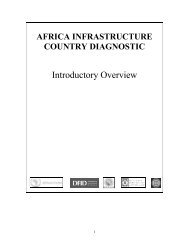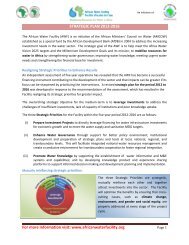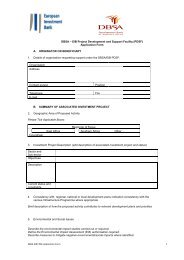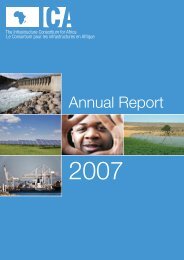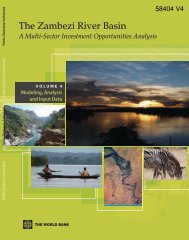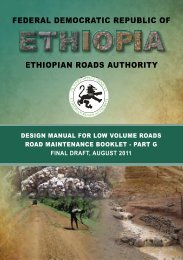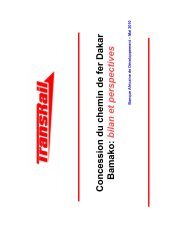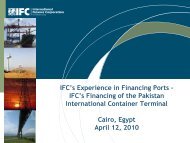Design-Manual-for-Low-Volume-Roads-Part-A
Design-Manual-for-Low-Volume-Roads-Part-A
Design-Manual-for-Low-Volume-Roads-Part-A
You also want an ePaper? Increase the reach of your titles
YUMPU automatically turns print PDFs into web optimized ePapers that Google loves.
A - Chapter 1 - 4<br />
about 300 vehicles per day. Such roads are referred to as “low-volume” roads in this manual and all are<br />
an essential component of the road system. Their importance and reach extends to all aspects of the<br />
economic and social development of rural communities and the country at large.<br />
1.2 <strong>Low</strong> volume road design principles<br />
Ethiopia is a country of great geographical, geological and climatic diversity. Altitudes range from the<br />
highest peak at Ras Dejen, 4,620 meters above sea level, down to the Afar Depression at about 110<br />
meters below sea level. Ethiopia’s high plateaus and mountain ranges, usually above 1500 meters are<br />
characterised by precipitous edges and dissection by numerous rivers and streams. These areas constitute<br />
about 45 percent of the total area and are inhabited by close to 80 percent of the population.<br />
Below 1500 meters are the lowland areas, located in the north-west, east and south. The vast majority<br />
of these areas support nomadic and semi-nomadic pastoralism. The descent to the southwest and west<br />
leads to the semi–humid lowlands. Climatic regions range from arid, tropical rainy to temperate rainy<br />
areas.<br />
Soils are highly variable and often problematic, available materials <strong>for</strong> construction can be very variable<br />
or scarce and involve long haulage.<br />
Hence, traditional engineering, and traditional road engineering in particular, is challenging in the face<br />
of such diversity. For low volume road provision the challenges can be even greater. <strong>Low</strong> volume roads<br />
provide important links from homes, villages and farms to markets and offer communities access to<br />
health, education and other services. These roads also provide important links between Kebele and<br />
Wereda centres and the Federal road network. Given their importance, design engineers need to work<br />
with and around such challenges. Clients also need to be flexible and adaptable, if low volume roads are<br />
to be provided at reasonable cost.<br />
Typically in Ethiopia, low volume roads are unpaved with a gravel or earth wearing surface. Very few<br />
are in good condition and can provide the level of all-weather access that is required. Budgets <strong>for</strong> the<br />
improvement and maintenance of these roads are constrained. In facing the challenge of improving<br />
the low volume road network, the application of the conventional planning, design, construction and<br />
maintenance philosophies used <strong>for</strong> higher traffic roads is unlikely to provide an optimal solution.<br />
In determining cost-effective solutions <strong>for</strong> the provision of low volume roads it is important to understand<br />
the mechanics of how the road deteriorates in the first place. Deterioration of the existing unpaved low<br />
volume roads in Ethiopia is governed by the type of material used on the surface (gravel to soil); the<br />
strength of the underlying soil (soft, erodible and/or expansive), the type and action of traffic (heavy<br />
vehicle to pedestrian) and probably most importantly, the influence of the “road environment”. The term<br />
“road environment” includes both the natural or bio-physical environment and the human environment.<br />
It includes the interaction between the different environmental factors and the road structure. Some of<br />
these factors are uncontrollable, such as those attributable to the natural environment, including the<br />
interacting influence of climate (eg wind, rainfall and intensity), local hydrology and drainage, terrain and<br />
gradient. Collectively, these will influence the per<strong>for</strong>mance of the road and the design approach needs<br />
to recognise such influence by providing options that minimise the negative effects. Others factors, such<br />
as the construction and maintenance regime; safety and environmental demands; and the extent and<br />
type of traffic are largely controllable and can be more readily built into the design approach.<br />
Typical road environment factors are presented in Figure A.1.2 and covered in more detail in <strong>Part</strong> D,<br />
Chapter 6 of the <strong>Manual</strong>.<br />
PART A: DESIGN STANDARD APPROACHES




